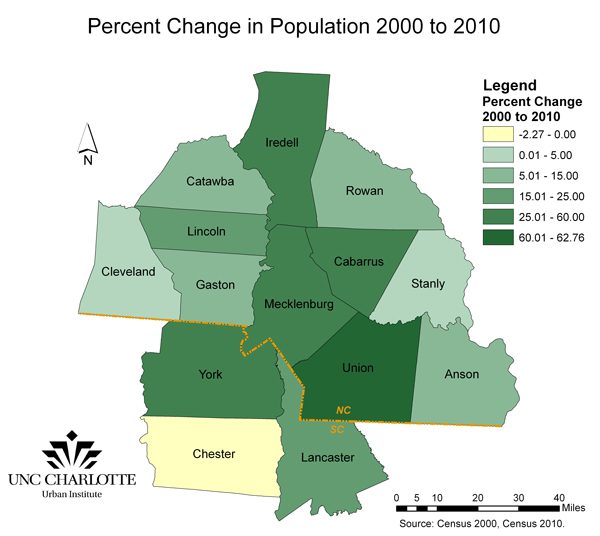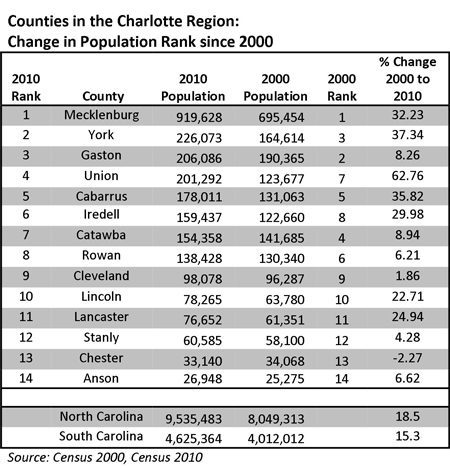Census 2010: South Carolina Counties in the Charlotte Region

The recently released South Carolina data from US Census 2010 now allow for a more complete picture of growth in the Charlotte Region in the last decade. The South Carolina counties of Chester, Lancaster and York form the southern flank of the 14-county Charlotte Region. The census data show York County was the second-fastest growing of all South Carolina’s counties since 2000 with a population increase of over 37%. That growth was enough to make it the second fastest-growing county in the 14-county Charlotte (Union County, NC saw the largest percentage increase in North Carolina or South Carolina at over 60%). The growth in York County was particularly strong in communities like Tega Cay, Lake Wylie and Fort Mill, all near Charlotte.
An example of the types of development that have occurred in York County since 2000 is Baxter Village, near Fort Mill. With over 1200 homes, the development mixes residential with a business district that is built to resemble a small town. “I think this development has been attractive because it has a real center. It was conceived as a high amenity place with services like schools in the plan from the beginning,” says Bill McCoy, emeritus faculty at UNC Charlotte.

Lancaster County, with burgeoning growth in the northern “panhandle” near the Ballantyne area of Charlotte, also saw substantial growth during the decade. Lancaster County’s population grew by nearly 25% since 2000. That development has included Sun City Carolina Lakes, another large and successful residential project, which is designed for the 55 and older age group.
Chester was the only county within the 14-county Charlotte region to experience a population loss since the 2000 census, losing 2.27% during the decade. This is a change for Chester and the region from the previous census, when no counties in the Charlotte Region lost population. Chester has experienced higher unemployment than other counties in the region over much of the past decade as the county’s traditional manufacturing base has declined, and the latest population numbers reflect the economic challenges Chester has faced.

Reviewing how the 14 counties compared across both states, after Union’s blistering growth of nearly 63%—York, Cabarrus and Mecklenburg all exceeded 30% increases in the last decade. York County’s growth moved it up to the second most-populous county in the region, from third in the year 2000. Iredell, Lancaster and Lincoln all exceeded 20% growth. The other counties in the region fell below the state averages for both North and South Carolina. (Overall, South Carolina grew by 15.3% from 2000–2010, compared to a North Carolina growth rate of 18.5%). So, while the Charlotte Region is clearly one of the centers for population growth in both Carolinas, half the counties that form the Charlotte Region grew by less than either states’ averages – another indicator of a growing disparity between the region’s inner and outer counties that is also reflected in unemployment rates and measures of income.
Looking at the overall patterns of growth throughout the Carolinas, it becomes clear that both states’ population growth in the last decade was unevenly distributed. The highest growth was concentrated in relatively few counties in urban and suburban areas.
http://2010.census.gov/2010census/data/ This interactive Census data tool allows for exploration of the changes that occurred nationally and at the state level in the period 2000 to 2010.
Photograph courtesy of Clear Springs Development